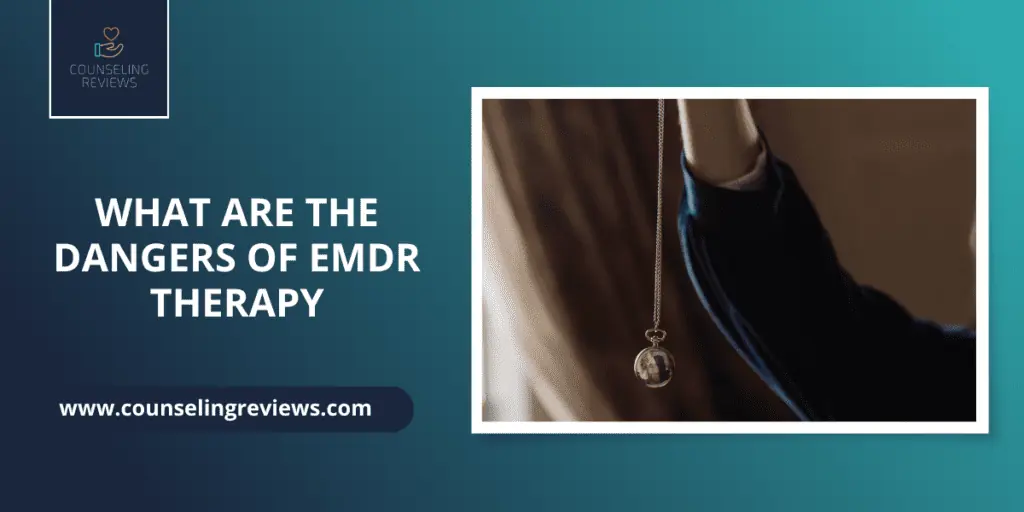Eye movement desensitization and reprocessing therapy, also known as EMDR, is a form of psychotherapy originally developed to heal post-traumatic stress disorder (PTSD). Francine Shapiro, an American psychologist, developed this treatment in the 1980s.
EMDR differs from other kinds of therapy as it involves not only traditional talk therapy but also recalling traumatic images, thoughts, bodily sensations, and emotions in conjunction with bilateral stimulation. Bilateral stimulation, in the context of EMDR, refers to finger tapping and repeated horizontal eye movements.
The WHO states that EMDR has low-to-moderate evidence for treating stress. In contrast, the United Kingdom’s National Institute for Health and Care Excellence’s 2018 report says it has only low-to-very-low evidence for treating PTSD.
EMDR is very popular in certain circles, while others have also challenged it. In this article, we closely examine what EMDR therapy is and why some people think it is dangerous.
What is EMDR Therapy?
EMDR is a structured therapy in which the therapist asks the client to focus briefly on a traumatic memory. While focusing on this memory, the therapist requests the client to make horizontal eye movements to induce bilateral stimulation. Bilateral finger tapping may be used as well. Other times, eye movements are used in addition to finger tapping while recalling a traumatic memory to process it less vividly.
The therapy is based on Shapiro’s Adaptive Information Processing model of trauma, which suggests that traumatic memories cause distress because the individual has not adequately processed them. These unprocessed memories consist of thoughts, emotions, and physical sensations, which can be very disturbing to the individual.
While other forms of therapy focus on processing feelings, thoughts, and behaviors associated with traumatic memories, EMDR specifically focuses on the memories themselves. Some clinical observations suggest when people experience bilateral stimulation while recalling traumatic memories, their effects reduce in their intensity.
For example, if you have PTSD, your EMDR therapist may ask you to recall an event that disturbs you while rhythmically tapping your left and right fingers. The therapist may also ask you to move your eyes from side to side, also known as saccadic movements. When you experience bilateral stimulation while recalling traumatic memories, their vividness reduces significantly — at least according to the proponents.
Is EMDR Therapy Dangerous?
EMDR therapy is not a dangerous therapy. However, it is important to be aware of the potential risks and side effects so that you can make an informed decision about whether or not it is right for you.
If you are considering EMDR therapy, it is important to find a therapist who is experienced and qualified in this type of therapy. You should also feel comfortable talking to your therapist about your concerns and expectations.
Here are some additional tips for staying safe during EMDR therapy:
- Be sure to tell your therapist about any past experiences with trauma or abuse.
- Let your therapist know if you are feeling overwhelmed or uncomfortable at any time.
- Take breaks as needed.
- Trust your intuition. If you feel like something is not right, speak up.
What Can You Expect From EMDR Therapy?
EMDR has a concrete structure that is taught professionally to the therapists. EMDR therapists need to undergo training and obtain certifications before they can administer this form of therapy. Here are the eight phases of EMDR, according to the American Psychological Association:
1. Case history-taking and planning the treatment
During the first phase, your therapist obtains a complete picture of your PTSD. To do so, they conduct a clinical interview, also known as “case history taking.” This phase may include initial assessments to identify triggers, list traumatic memories, and set goals for future sessions.
2. Psychoeducation
Although the APA does not use the term “psychoeducation,” the second phase involves the therapist explaining how EMDR therapy works, what to expect from practicing bilateral eye movements and finger tapping, and understanding the concept of “Safe/Calm Place exercise.” This exercise helps the client to stop processing traumatic memories if they become unbearable.
3. A deeper understanding of trauma
Unlike the initial assessments administered as part of case history taking, the third phase involves a very EMDR-specific approach to evaluation. During this phase, the client’s traumatic memories are activated to identify images, cognitions, emotions, and physical sensations associated with those memories. To objectively measure these factors, EMDR therapists use the Validity of Cognition (VOC) scale and the Subjective Units of Disturbance (SUD) scale.
- The Validity of Cognition (VOC) scale attempts to evaluate how true a thought may be on a scale of 1 to 7.
- The Subjective Units of Disturbance (SUD) scale assesses the intensity of the emotion felt during the recollection of a traumatic memory on a scale of 0 to 10.
4. Desensitization
During the fourth phase, the therapist teaches the client to focus on traumatic memories while performing eye movements or finger tapping to induce bilateral stimulation. The client narrates the thoughts they experience, and BLS is performed until the thoughts are no longer distressing. This may take several sessions. Some may find this phase similar to exposure therapy, which is a form of behavior therapy.
5. Installation
During the fifth phase of the EMDR treatment, negative thoughts are replaced with preferred cognitions. This is where it begins to seem like cognitive behavior therapy. However, there is less talking and more doing during an EMDR session.
For instance, during a CBT session, your therapist may actively encourage you to speak about your thoughts, emotions, and daily activities. During an EMDR session, your therapist is more concerned about helping you process difficult memories and replacing them with positive thoughts.
6. Body Scanning
As trauma includes physical sensations, EMDR ensures that these aren’t ignored while only focusing on thoughts and emotions. Some people feel tingling, shivering, shaking, and other sensations when they recall unpleasant memories. These physical sensations may harken back to the past and strongly relate to the traumatic incident. Bilateral stimulation is induced until unpleasant bodily sensations fade away.
7. Closure
This is the seventh phase of an EMDR session, when the therapist provides specific instructions and techniques to remain safe until the next session. As you may have re-lived your trauma during the session and its associated physical and emotional consequences, you may need time to compose yourself. Basic self-care routines and avoiding anything triggering should help you get by that particular day.
8. Re-evaluation
The subsequent session begins with re-evaluating what happened during the gap between the two sessions. This provides the basis for what must be done during that particular session.
Each EMDR session may last up to 90 minutes and require many visits until an individual sees improvement.
Here are the advantages and disadvantages of EMDR
| Advantages of EMDR | Disadvantages of EMDR |
| EMDR was specifically developed to treat trauma. | Finding a trained EMDR therapist can be difficult. |
| It has been proven effective for several other psychological conditions, such as depression, substance abuse, PTSD, etc. | People with psychosis and certain personality disorders may not benefit from EMDR. |
| You require fewer sessions of EMDR therapy when compared with other therapeutic modalities. | It does not venture deep into your mind and address emotional and cognitive issues that have festered since childhood. |
| EMDR can be used as an adjunct therapy. It works perfectly well alongside CBT, DBT, and other forms of therapy. | This can prove to be very expensive, especially when clients have to take multiple sessions of different types. |
| EMDR effects tend to be long-lasting, according to some people. | Although EMDR has been praised by many, there isn’t sufficient evidence to back it up. |
| EMDR is excellent for people who are not forthcoming when sharing their trauma. | Insurance companies usually do not cover EMDR. |
| EMDR does not require discussing highly distressing thoughts or being challenged by the therapist. | Some people report feeling disturbed after the session and find it hard to process emotions between sessions. |
What Are the Side Effects of EMDR Therapy?
EMDR therapy is different from other forms of treatment, as it involves body scanning, bilateral stimulation, and a longer time in the therapist’s office. Hence, the side effects differ slightly when compared with other forms of psychotherapy.
1. Feeling triggered
As clients recall traumatic memories, they may often feel overwhelmed or very emotional. Distressing thoughts may emerge, and you may feel like sobbing. However, the therapist will be with you to help you process these emotions — the goal of this therapy is to process complicated feelings anyway.
2. Unpleasant sensations
EMDR involves bilateral stimulation, and hence, a person may feel fatigued. They may also experience headaches, often the consequence of recalling painful memories. Other physical sensations include increased heart rate, sweating, muscle tension, etc., all typical symptoms of reliving trauma or anxiety.
3. Persisting symptoms
After your session, you may continue to feel unpleasant if you cannot fully process difficult emotions. Hence, you may find it difficult to sleep, experience tiredness, etc. However, your therapist will teach you sleep hygiene and relaxation exercises to help you overcome these side effects.
Who Benefits From EMDR Therapy?
EMDR can help a wide range of people to address their trauma and difficult memories. Here are some specific groups of people who can benefit from EMDR therapy.
1. People who find it difficult to talk about their trauma
Many people find traditional forms of therapy complex as they cannot express themselves. As a result, therapists often spend many sessions trying to build rapport with the client. If you are someone who finds it difficult to talk about your problems or traumatic memories, EMDR can help. It requires minimal talking, and the therapist will always be around if recalling painful memories overwhelms you.
2. People who need clarity regarding their past
Most forms of psychotherapy do not focus on memories. However, EMDR places significant importance on memories. Therapeutic modalities such as CBT emphasize addressing automatic negative thoughts and maladaptive behaviors. This helps people to gain clarity regarding their past and overcome emotional struggles that they find difficult to articulate.
3. People with unexplained physical sensations
An often ignored aspect of mental health issues is that people with anxiety, PTSD, and other mental health conditions experience unpleasant physical sensations. Although CBT and other therapies teach relaxation exercises to minimize uncomfortable physical sensations, EMDR focuses on bodily sensations during the body scanning phase. This helps address unexplained physical sensations.
4. People with certain mental health conditions
EMDR was specifically developed to help people process painful memories. Painful memories and flashbacks are symptoms of PTSD, and EMDR was designed as a treatment for PTSD. However, it can also help people with depression, anxiety, or just about anyone who needs to process unpleasant memories.
What Are the Dangers of EMDR Therapy?
EMDR is not dangerous per se. We have already covered the side effects you may experience, which are often necessary to process your trauma completely.
Let’s bust four common myths involving dangers associated with EMDR therapy:
1. You will be overwhelmed by trauma.
EMDR is not specifically overwhelming. While recalling traumatic memories is unpleasant, and you may feel overwhelmed during your therapy sessions, your therapist will always support you. This is true of any therapy that addresses trauma.
2. It will worsen your condition.
Although many psychologists have raised doubts about EMDR’s efficacy, it is certainly not dangerous. It will not make you feel worse than you already do. You may experience emotionally intense feelings, but it is necessary to experience them to desensitize yourself gradually. Behavior therapy uses similar techniques called In Vivo/In Vitro techniques, where an individual is asked to imagine or is exposed to a feared stimulus and then asked to perform relaxation exercises until the fear-inducing stimulus fades away.
3. EMDR cannot help people with other mental health conditions
Many psychological conditions involve painful memories. People with substance abuse disorders, depression, and anxiety could benefit from EMDR as it provides an outlet to process distressing memories even if they weren’t particularly traumatic.
4. EMDR will create memories out of nowhere
This is a misconception that needs to be busted. EMDR cannot plant memories in your mind. However, you may remember incidents that had long been forgotten. These memories must be processed during the therapy sessions to address lingering trauma. Hence, it is safe to seek EMDR therapy if you can access it.
How to Find an EMDR Therapist
EMDR therapy is popular worldwide, and in most metropolitan areas, you should be able to find someone trained in this form of treatment. Usually, EMDR therapists tend to be licensed mental health professionals such as clinical psychologists, family therapists, social workers, etc.
As licensure-related rules vary across borders, it is necessary to make sure that you seek EMDR therapy from someone who has a license to treat mental health conditions.
In addition, you can visit EMDR Therapist Directory by EMDRIA to find out if a certified therapist is nearby. EMDR Institute has a list of therapists too. It is important to note that full certification is not necessary to practice EMDR.
However, it is a specialized form of therapy that differs from other talk therapies. Hence, it is strongly recommended to seek EMDR therapy from someone trained in it.
Alternatives of EMDR Therapy
EMDR therapy is not easily accessible outside large metropolitan areas. Even in large cities, you may find it challenging to access therapists adequately trained in EMDR. However, PTSD is a severe mental health condition that needs professional attention. Thankfully, there are several alternatives to EMDR therapy.
Here are a few:
- Cognitive Behavior Therapy (CBT) for trauma: CBT helps you understand the relationship between your thoughts, feelings, and behaviors. It highlights that changes in any domain will improve your functioning in other areas. People with PTSD often develop core beliefs such as “the world is dangerous,” “no one will help me,” “I am not safe,” etc. The therapist tries to replace these beliefs with more helpful thoughts to reduce trauma-related distress.
- Schema Therapy: Dr. Jeffrey Young developed Schema Therapy to treat Borderline Personality Disorder. However, it has since been used to treat many other mental health conditions, including substance abuse, PTSD, eating disorders, etc. Schema Therapy goes deeper into your childhood experiences to understand how you developed maladaptive thinking patterns and behaviors. Hence, it also addresses traumatic memories which may not be addressed during regular CBT sessions.
- Acceptance and Commitment Therapy (ACT): ACT is a form of therapy that helps you accept difficult emotions instead of avoiding them. It enables you to recognize that running away from pain is not possible and that trying to control it also has the same effect. Instead, ACT helps you take a step back, see yourself as separate from your thoughts, and commit to taking action. However, for severe forms of PTSD, ACT may not be the appropriate form of therapy.
Online Therapy for Trauma is Convenient
People experience different kinds of traumatic incidents. PTSD often involves physical or sexual assault, domestic violence, natural disasters, wars, the death of a loved one, being bullied as a child, etc. These incidents can have a lasting effect on the individual and cause flashbacks of distressing memories — a hallmark symptom of PTSD.
Trauma-focused therapy helps you address PTSD directly and come to terms with it. Although traditional forms of treatment such as CBT, schema therapy., and others can help you deal with PTSD, you may not always have access to in-person therapy sessions. In such cases, online therapy can be effective to a large extent.
Telecounselling helps you receive the care you need from a distance and makes mental health care more accessible. You can speak to your trauma therapist from the comfort of your house without having to commute. Click here to find a trauma-focused online therapist.





